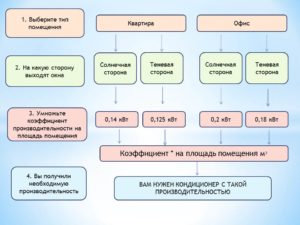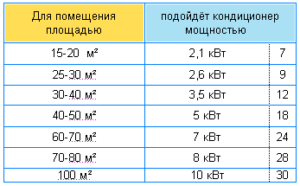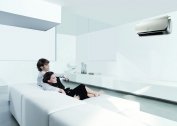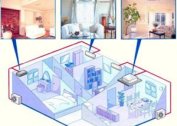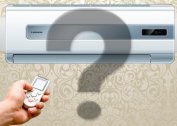The main parameter by which climatic equipment is selected is the power of the air conditioner. The parameter shows the performance of HVAC equipment for cold and heating. A competent calculation of the power of a split system takes into account the area of the room and all sources of thermal radiation. A correctly selected air conditioner will provide a comfortable microclimate without overpaying for electricity.
What is the power of the split system (kW per 1 sq. M area)
Air conditioners are used to cool the room, less often to raise the temperature. Modern models simultaneously moisturize and purify the air, but these are additional functions. When choosing the best option, they are guided by the cooling capacity of the model.
An approximate calculation of a split system is usually done according to the formula - 1 kW per 10 square meters. m square. It is correct for rooms in an apartment or a private house with a ceiling height of 2.7-3 m.
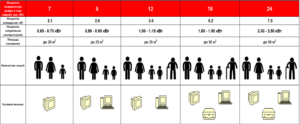 Given that there are appliances in the room and people who produce heat, add a margin of 15-20%. Office, retail or industrial premises filled with heat sources are calculated using more complex formulas.
Given that there are appliances in the room and people who produce heat, add a margin of 15-20%. Office, retail or industrial premises filled with heat sources are calculated using more complex formulas.
Choosing the power of an air conditioner for a specific room
The power of split systems is measured in kW or BTU (BTU). The British marking for measuring heat energy can be found in the characteristics of climate technology. The ratio between kilowatts and BTUs:
- 1 kW = 3412 BTU / h;
- 1 BTU / h = 0.2931 kW.
Cooling capacity is indicated by round numbers: 5000 BTU, 7000 BTU, 9000 BTU up to 30 000 BTU. The marking of the models simply indicates the number 5 “five”, 7 “seven”, 9 “nine”. For preliminary calculation of the split system by the room area, the power in the BTU is multiplied by 3.
Air conditioners at 5000 BTU / h (1.6 kW) are designed for a room of 15-16 sq.m. More productive systems of 7,000 BTU / h (2.1 kW) are suitable for a room of 21-22 square meters. m. This is a popular option among buyers, the technique corresponds to the average area of the living room or hall.
When choosing climatic equipment for a particular room, not only dimensions, but also related factors are taken into account. The approximate calculation of power is inaccurate. A lack of capacity will cause the compressor to operate at its limit. The engine will burn out quickly, and the replacement is expensive. A significant supply is also harmful. This is an extra waste of money and electricity. During operation, a productive air conditioner quickly cools the room, but due to an increase in temperature it turns on again. Frequent start-up and shutdown of mechanisms accelerates wear.
Power consumption
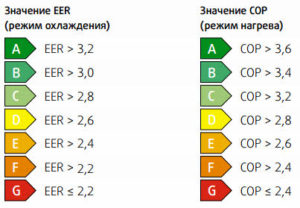 In the characteristics of air conditioners, two types of power are indicated: consumed and produced. They determine the different parameters of the operation of the equipment. Power consumption is the amount of energy necessary for the operation of the device. Its value depends on the energy efficiency of the split system. Class A air conditioners consume electricity 60-70% less than class G models.
In the characteristics of air conditioners, two types of power are indicated: consumed and produced. They determine the different parameters of the operation of the equipment. Power consumption is the amount of energy necessary for the operation of the device. Its value depends on the energy efficiency of the split system. Class A air conditioners consume electricity 60-70% less than class G models.
Comparing the values of power consumption and generation, it is easy to notice that less energy is consumed than is obtained. For example, a 700 W air conditioner produces 2000 W (2 kW) cold. The efficiency of the installation is 300%.
A feature of the climate technology is the transfer of heat using refrigerant. Electric energy is converted into mechanical energy. Climate control plants do not produce cold, but remove excess heat from the room.
The ratio of power consumption to cooling capacity is the main indicator of the energy efficiency of climate technology. It is indicated by the coefficient EER.In household appliances, its value is 2.5-4. For heating, a similar formula and COP coefficient are derived. Its parameters are in the range of 2.8-5.
The performance of the equipment also has two parameters: cooling and heating. The temperature lowering mode is used more often, therefore they focus on it. The heat output of a split is 3.6-5.5 kW per 1 kW of consumed electricity. The indicator is higher than in the cold. The difference is due to the lack of heat loss on the highway.
Most models are not designed to operate at outdoor temperatures below -5 °. In the off-season, heating an air-conditioned room will cost less than an electric heater.
Detailed calculation of air conditioning performance
To pre-calculate the power of a split system, enough information about the area of the room. It is correct to use data by volume, but it is difficult to multiply the parameters immediately. When correctly calculating performance, additional factors are taken into account:
- location on the cardinal points (south, north);
- glazing area;
- the number of people gathering in the room at the same time;
- the influx of heat from household appliances, electrical appliances;
- exposure to solar radiation, the presence of protection on the window;
- the location of the premises on the top floor is hotter in summer from a heated roof.
The rooms are more than 70 square meters. m power calculation by area is not suitable. The split system is selected by the total heat influx.
Calculation Formulas
The exact power indicator of a split system depending on the area and height is calculated according to the formula:
Q = S * h * q, where
- S is the area of the premises, sq. m;
- h - ceiling height, m;
- q is the coefficient of activity of lighting, W / cu. m. Intensive (south side) - 40, middle (east and west windows) - 35, low (north side, tree shade) - 30.
The total performance in the cold is calculated by the formula:
Q = Q1 + Q2 + Q3, where
Q1 - heat input from building envelopes. The parameter formula is presented above Q1 = S * h * q.
Q2 - human energy release. The value depends on the age and degree of physical activity:
- adult in a calm state - 100 W;
- light load - 125 W;
- hard physical work or intense sports - 200 watts.
For children aged 5-12 years, a coefficient of 50 watts. When calculating the total heat gain when installing an air conditioner in the house, an average of 110 W is taken, which is multiplied by the number of family members.
Q3 - heat flows from household appliances. The estimated coefficient of lighting and other devices is 30% of the power consumption.
- TV - 200 W;
- computer - 300 W
It is not necessary to purchase a model that is 100% consistent with the design capacity. Allowed fluctuations in the range of 5% lower or 15% higher than the calculated refrigerating capacity.
Calculation example
- room area 25 square meters. m;
- ceiling 2.5 m;
- number of people - 3 adults with a light load;
- east side, average light intensity;
- equipment - TV and computer.
Q1 = 25 * 2.5 * 35 = 2188 W (2.2 kW)
Q2 = 3 * 125 = 375 W (0.38 kW)
Q3 = 300 + 200 = 500 W (0.5 kW)
Full power of the air conditioner for cooling
Q = 2.2 + 0.38 + 0.5 = 3.08 kW
Given a small percentage of the stock, split systems with a capacity of 2.93-3.38 kW are suitable.
Additional criteria for the selection of HVAC equipment are: manufacturer, type of air conditioner, functionality, design of the indoor unit. In living conditions, split-systems are the leaders in terms of price and comfort.
